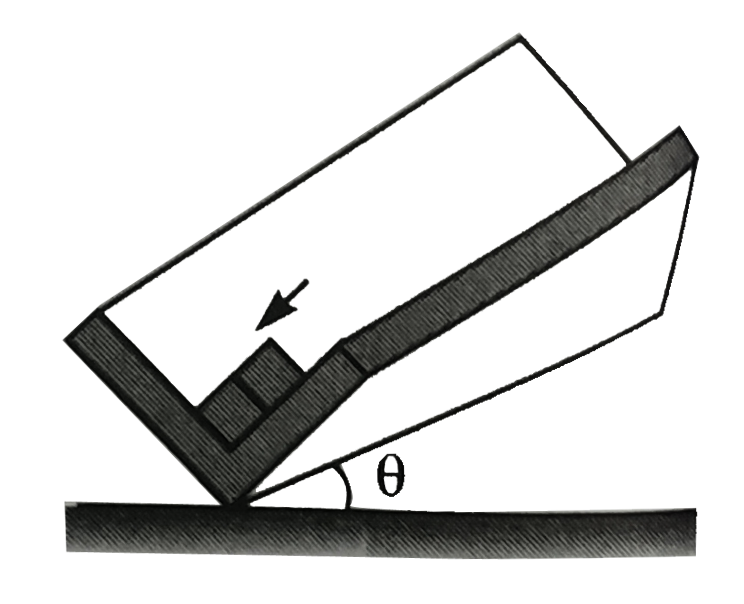A block of mass m is moving with a constant acceleration a on a rough horizontal plane. If the coefficient of friction between the block and ground is μ, the power delivered by the external agent in a time interval t from the beginning is equal to:
ma2y
μ mgat
μm(a+μg) gt
m(a+μg)at
The correct Answer is:D
To solve the problem step-by-step, we will analyze the forces acting on the block and calculate the power delivered by the external agent.
Step 1: Identify the forces acting on the block
The block of mass m is moving on a rough horizontal plane with a constant acceleration a. The forces acting on the block include:
- The external force F applied by the agent.
- The frictional force f opposing the motion, which can be calculated using the coefficient of friction μ and the normal force (which is equal to mg for horizontal motion).
Step 2: Write the equation of motion
Using Newton's second law, the net force acting on the block can be expressed as:
F−f=ma
Where f=μmg (the frictional force). Therefore, we can rewrite the equation as:
F−μmg=ma
Step 3: Solve for the external force F
Rearranging the equation gives:
F=ma+μmg
Factoring out m from the right-hand side:
F=m(a+μg)
Step 4: Determine the velocity of the block after time t
Using the kinematic equation for velocity:
V=U+at
Assuming the initial velocity U=0 (the block starts from rest), we have:
V=at
Step 5: Calculate the power delivered by the external agent
Power P delivered by the external force is given by the product of the force and the velocity:
P=F⋅V
Substituting the expressions for F and V:
P=(m(a+μg))(at)
This simplifies to:
P=m(at)(a+μg)
Thus, the final expression for the power delivered by the external agent is:
P=m(at)(a+μg)
Final Answer
The power delivered by the external agent in a time interval t is:
P=m(at)(a+μg)
---
The block of mass m is moving on a rough horizontal plane with a constant acceleration a. The forces acting on the block include:
- The external force F applied by the agent.
- The frictional force f opposing the motion, which can be calculated using the coefficient of friction μ and the normal force (which is equal to mg for horizontal motion).
Using Newton's second law, the net force acting on the block can be expressed as:
F−f=ma
Where f=μmg (the frictional force). Therefore, we can rewrite the equation as:
F−μmg=ma
Rearranging the equation gives:
F=ma+μmg
Factoring out m from the right-hand side:
F=m(a+μg)
Using the kinematic equation for velocity:
V=U+at
Assuming the initial velocity U=0 (the block starts from rest), we have:
V=at
Power P delivered by the external force is given by the product of the force and the velocity:
P=F⋅V
Substituting the expressions for F and V:
P=(m(a+μg))(at)
This simplifies to:
P=m(at)(a+μg)
Thus, the final expression for the power delivered by the external agent is:
P=m(at)(a+μg)
The power delivered by the external agent in a time interval t is:
P=m(at)(a+μg)
Similar Questions
A horizontal constant force F pulls a block of mass m placed on a horizontal surface. If the coefficient of kinetic friction between the block and ground is μ, find the power delivered by the external agent after a time agent after a time t measured from the beginning of action of the force.
View SolutionA block of mass m is pulled by a force of constant power P placed on a rough horizontal plane. The friction coefficient between the block and the surface is μ. Then
View SolutionA block of mass m is moving on a rough horizontal surface. μ is the coefficient of kinetic friction between the block and the surface. What is the net force exerted by the surface on the block?
View SolutionA block of mass m is placed at rest on an inclination θ to the horizontal. If the coefficient of friction between the block and the plane is μ, then the total force the inclined plane exerts on the block is
View SolutionA block of 10kg is pulled at a constant speed on a rough horizontal plane by a force of 20N. Calculate the coefficient of friction ?
View SolutionA block of mass m is pulled by a constant powert P placed on a rough horizontal plane. The friction coefficient the block and surface is μ. The maximum velocity of the block is.
View SolutionA block of mass m slides down an inclined plane which makes an angle θ with the horizontal. The coefficient of friction between the block and the plane is μ. The force exerted by the block on the plane is
View SolutionA block of mass m sides down an inclined right angled trough .If the coefficient of friction between block and the trough is μk acceleration of the block down the plane is
 View Solution
View SolutionA block of mass m moves with constant speed down the inclined plane of inclination θ. Find the coefficient of kinetic friction.
 View Solution
View SolutionA block of mass m is kept on a horizontal table. If the static friction coefficient is μ., find the frictional force acting on the block.
View Solution

